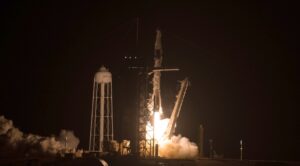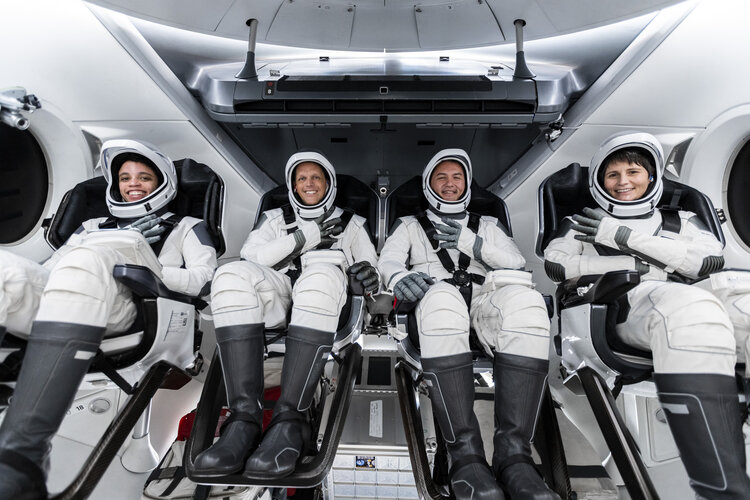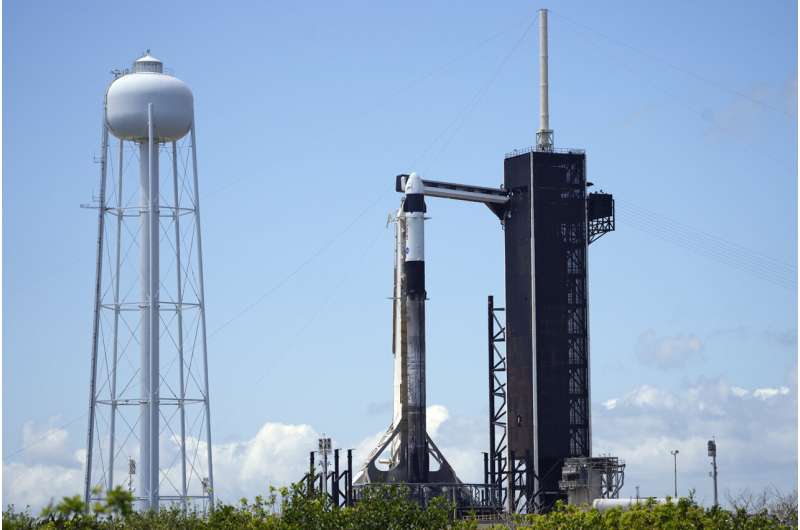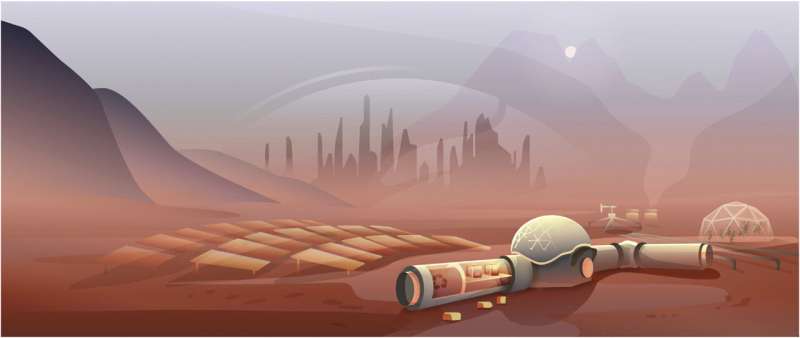SpaceX launches its latest crew to ISS for NASA
Wednesday, 27 April 2022 08:01 Days after a SpaceX Dragon capsule crewed by wealthy adventurers splashed down off Florida's coast, another launched Wednesday, this time for a NASA mission to the International Space Station.
The Crew-4 mission blasted off from the Kennedy Space Center at 3:52 am (0752 GMT), carrying Americans Kjell Lindgren, Bob Hines and Jessica Watkins, as well as Italian Samantha Cristoforetti of the Eu
Days after a SpaceX Dragon capsule crewed by wealthy adventurers splashed down off Florida's coast, another launched Wednesday, this time for a NASA mission to the International Space Station.
The Crew-4 mission blasted off from the Kennedy Space Center at 3:52 am (0752 GMT), carrying Americans Kjell Lindgren, Bob Hines and Jessica Watkins, as well as Italian Samantha Cristoforetti of the Eu Xi Focus: Invigorating China's space exploration dream
Wednesday, 27 April 2022 08:01 On April 24, 1970, a young man in a village in Northwest China's Shaanxi province was thrilled to get the news that China sent its first satellite Dongfanghong 1 into space.
That young man, Xi Jinping, later became Chinese President.
Still having his eyes on stars today, Xi, also general secretary of the Communist Party of China (CPC) Central Committee and chairman of the Central Mil
On April 24, 1970, a young man in a village in Northwest China's Shaanxi province was thrilled to get the news that China sent its first satellite Dongfanghong 1 into space.
That young man, Xi Jinping, later became Chinese President.
Still having his eyes on stars today, Xi, also general secretary of the Communist Party of China (CPC) Central Committee and chairman of the Central Mil Scientists model landscape formation on Titan, revealing an Earth-like alien world
Wednesday, 27 April 2022 08:01 Saturn's moon Titan looks very much like Earth from space, with rivers, lakes, and seas filled by rain tumbling through a thick atmosphere. While these landscapes may look familiar, they are composed of materials that are undoubtedly different - liquid methane streams streak Titan's icy surface and nitrogen winds build hydrocarbon sand dunes.
The presence of these materials - whose mechani
Saturn's moon Titan looks very much like Earth from space, with rivers, lakes, and seas filled by rain tumbling through a thick atmosphere. While these landscapes may look familiar, they are composed of materials that are undoubtedly different - liquid methane streams streak Titan's icy surface and nitrogen winds build hydrocarbon sand dunes.
The presence of these materials - whose mechani Falcon 9 launches Crew-4 mission to space station
Wednesday, 27 April 2022 07:32
Four American and European astronauts are on their way to the International Space Station after their launch on a Crew Dragon spacecraft April 27, less than two days after another spacecraft returned from the station.
Watch live: Crew-4 docking to the International Space Station
Wednesday, 27 April 2022 07:00
Follow the live coverage as the SpaceX Crew Dragon docks on the International Space Station, marking the beginning of ESA astronaut Samantha Cristoforetti’s Minerva mission.
Liftoff of Crew-4 to the International Space Station
Wednesday, 27 April 2022 07:00 Video:
00:03:55
Video:
00:03:55
The Falcon 9 rocket and Crew Dragon capsule carrying ESA astronaut Samantha Cristoforetti and NASA astronauts Kjell Lindgren, Robert “Bob” Hines and Jessica Watkins to the International Space Station lifts off from Launchpad 39A.
Collectively known as Crew-4, the four astronauts were launched at 08:52 BST/09:52 CEST Wednesday 27 April from NASA’s Kennedy Space Center in Florida USA. Transit to the Station is expected to take under 24 hours.
Samantha is the third ESA astronaut to travel to the orbital outpost in a Crew Dragon. During the journey she and Jessica will serve as mission specialists. Kjell is Crew-4
Watch live: Crew-4 enter the International Space Station
Wednesday, 27 April 2022 07:00
The SpaceX Crew Dragon docked with the International Space Station at 01:37 CEST on Thursday 28 April, marking the beginning of ESA astronaut Samantha Cristoforetti’s Minerva mission.
SpaceX launches 4 astronauts for NASA after private flight
Wednesday, 27 April 2022 06:57
SpaceX launched four astronauts to the International Space Station for NASA on Wednesday, less than two days after completing a flight chartered by millionaires.
It's the first NASA crew comprised equally of men and women, including the first Black woman making a long-term spaceflight, Jessica Watkins.
"This is one of the most diversified, I think, crews that we've had in a really, really long time," NASA's space operations mission chief Kathy Lueders said on the eve of launch.
Solar beats nuclear at many potential settlement sites on Mars
Wednesday, 27 April 2022 06:48
The high efficiency, light weight and flexibility of the latest solar cell technology means photovoltaics could provide all the power needed for an extended mission to Mars, or even a permanent settlement there, according to a new analysis by scientists at the University of California, Berkeley.
Most scientists and engineers who've thought about the logistics of living on the surface of the Red Planet have assumed that nuclear power is the best alternative, in large part because of its reliability and 24/7 operation. In the past decade, miniaturized Kilopower nuclear fission reactors have advanced to the point where NASA considers them to be a safe, efficient and plentiful source of energy and key to future robotic and human exploration.
SpaceX set to launch its latest crew to ISS for NASA
Wednesday, 27 April 2022 06:42 Days after a SpaceX Dragon capsule crewed by wealthy adventurers splashed down off Florida's coast, another is set to launch Wednesday, this time for a NASA mission to the International Space Station.
With weather appearing favorable, the Crew-4 mission should blast off from the Kennedy Space Center at 3:52 am (0752 GMT), carrying Americans Kjell Lindgren, Bob Hines and Jessica Watkins, as w
Days after a SpaceX Dragon capsule crewed by wealthy adventurers splashed down off Florida's coast, another is set to launch Wednesday, this time for a NASA mission to the International Space Station.
With weather appearing favorable, the Crew-4 mission should blast off from the Kennedy Space Center at 3:52 am (0752 GMT), carrying Americans Kjell Lindgren, Bob Hines and Jessica Watkins, as w NASA's moon rocket, spacecraft return for repair after scrubbed test
Wednesday, 27 April 2022 06:42 NASA's Space Launch System rocket and Orion spacecraft for the Artemis I mission arrived safely at Kennedy Space Center's Vehicle Assembly Building in Florida, the agency said Tuesday.
The SLS rocket and Orion spacecraft arrived at the assembly building after a 10-hour journey from launch pad 39B that began Monday morning, NASA confirmed.
Crews will now extend the work platforms
NASA's Space Launch System rocket and Orion spacecraft for the Artemis I mission arrived safely at Kennedy Space Center's Vehicle Assembly Building in Florida, the agency said Tuesday.
The SLS rocket and Orion spacecraft arrived at the assembly building after a 10-hour journey from launch pad 39B that began Monday morning, NASA confirmed.
Crews will now extend the work platforms NASA Chief expects cooperation with Russia on ISS to continue
Wednesday, 27 April 2022 06:42 NASA Administrator Bill Nelson said on Thursday that he has full confidence Russia will extend its cooperation with the United States on the International Space Station (ISS) based on the continuing close cooperation and warm personal relations between crews from both countries and their control teams back on earth.
"I see the friendliness between the two crews. I have that confidence that
NASA Administrator Bill Nelson said on Thursday that he has full confidence Russia will extend its cooperation with the United States on the International Space Station (ISS) based on the continuing close cooperation and warm personal relations between crews from both countries and their control teams back on earth.
"I see the friendliness between the two crews. I have that confidence that Back Through the Buttes! Sols 3456-3457
Wednesday, 27 April 2022 06:42 Our weekend drive brought us successfully to our planned stop. The priority in this Touch and Go drive plan is to image the buttes which surround us. Mastcam will image "Blackcraig" and "Maringma" buttes which lie on our left and right respectively as we continue to head down from the pediment, and "Deepdale" butte which is ahead of us in the distance.
Although we have imaged Blackcraig an
Our weekend drive brought us successfully to our planned stop. The priority in this Touch and Go drive plan is to image the buttes which surround us. Mastcam will image "Blackcraig" and "Maringma" buttes which lie on our left and right respectively as we continue to head down from the pediment, and "Deepdale" butte which is ahead of us in the distance.
Although we have imaged Blackcraig an Enigmatic rocks on Mars show evidence of a violent origin
Wednesday, 27 April 2022 06:42 Determining the history of Mars, how it formed and evolved over time, has been a goal of both orbiter and rover missions to the Red Planet for decades. Analyzing data from several of these Mars missions, a team of researchers led by Steve Ruff of Arizona State University's School of Earth and Space Exploration has determined that enigmatic olivine-rich bedrock in Gusev crater and in and around J
Determining the history of Mars, how it formed and evolved over time, has been a goal of both orbiter and rover missions to the Red Planet for decades. Analyzing data from several of these Mars missions, a team of researchers led by Steve Ruff of Arizona State University's School of Earth and Space Exploration has determined that enigmatic olivine-rich bedrock in Gusev crater and in and around J Chinese research institutions set to receive 4th batch of lunar samples
Wednesday, 27 April 2022 06:42 China has announced a list of research institutions that are set to receive the fourth batch of lunar samples brought back by the country's Chang'e-5 mission.
The samples, which weigh 8.768 grams, will be distributed to scientists at 11 research institutions, according to a notice issued by the Lunar Exploration and Space Program Center of the China National Space Administration.
The
China has announced a list of research institutions that are set to receive the fourth batch of lunar samples brought back by the country's Chang'e-5 mission.
The samples, which weigh 8.768 grams, will be distributed to scientists at 11 research institutions, according to a notice issued by the Lunar Exploration and Space Program Center of the China National Space Administration.
The 